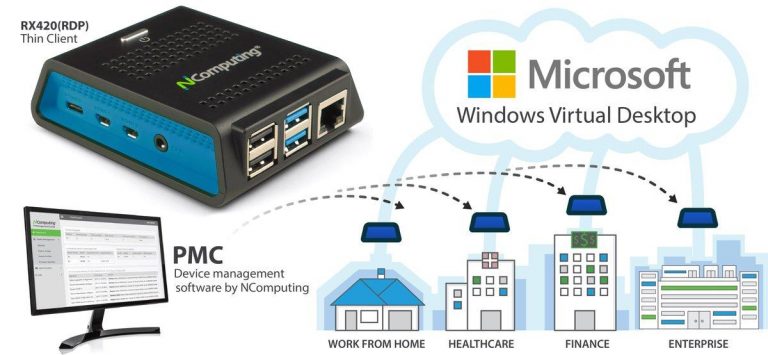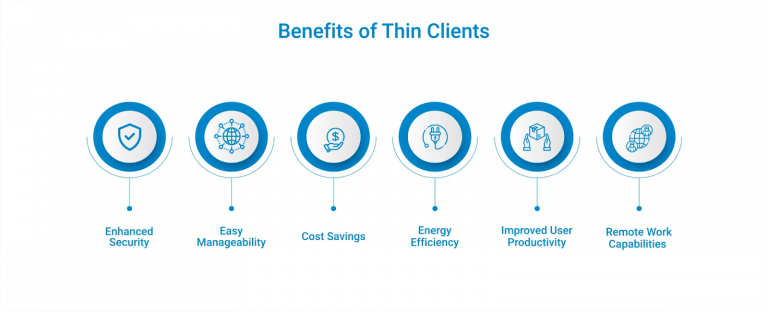A thin client is a computer that relies entirely on its network connection to complete tasks. A typical laptop or desktop computer (also known as a thick client) has the memory, storage capacity, and processing power to run applications and perform computing tasks independently. Thin client software connects to an on-premises or cloud-based environment that hosts applications, memory, and data users need. Thin client servers can be on-premises or cloud-based.
A thin client application enables companies to set up new workstations for remote or in-house employees at a much lower cost than providing everyone with new hardware. In addition, thin clients centralize security by securing various thin client-connected servers. Both desktop and thin laptop clients are available from a variety of manufacturers. Some companies focus on thin client solutions, while others offer thin client machines and thick clients as part of a broader product portfolio.
What are the different types of thin clients?
Thin clients can be divided into thin client software and thin client hardware.
Thin client software is simply an application that runs on any available host, whether dedicated or simple commodity hardware. It can use some of the features of the local host – such as hardware-based graphics acceleration – to better render the remote client’s user interface.
Hardware thin clients are devices explicitly designed to run thin client software. The exact composition of thin client hardware varies. It can be a PC that can only run client software or custom hardware that connects to the remote server and runs the necessary client display functions.
However, the exact choice of the host doesn’t have to be a system designed to connect clients – it can be a fully functional PC with its own workload, running thin client applications and other things at the same time.

How are thin clients used?
Thin client applications can be used in three ways: desktop virtualization, shared services, or browser-based computing.
In a virtualized desktop setup, including setups where each user has a remote desktop, each desktop exists in a virtual machine. Each machine is just a partition in a centralized server, and multiple partitions coexist, each serving a different user. These users have their applications and operating system, similar to a regular PC. The operating system and applications are not shared resources but are still physically located on remote servers. These virtualized resources can be accessed from any device connected to the server. Additionally, as long as a device can connect to a server, it can utilize the resources running on it, allowing for greater flexibility and more agile deployments.
When terminal services are shared, users on different thin client workstations can use the same operating system and applications because they are running from a central server. What users can do is limited as all activities must be approved by the IT department. This can benefit organizations as user activity can be restricted to using specific, secure, or protected applications.
With a browser-based architecture, the device’s application-related functions run in the browser rather than through a remote server. While data processing occurs on the thin client itself, the software and data must be accessed through a connection to the network. Using a browser-based thin client approach means that ordinary devices connected to the Internet perform their application functions in a web browser rather than on a remote server. Data processing takes place on thin client computers, but software and data are retrieved from the network.
What are the benefits of thin clients?
Thin client deployment is more cost-effective than deploying regular PCs. Because so much is centralized at the server-side, thin client computing can reduce IT support and licensing costs.
Better centralized security
Using a thin client improves security because the server itself limits it. Thin clients cannot run any software unless authorized at the server level, and data cannot be copied or stored anywhere other than on the server. Systems based on thin client architecture are easier to monitor because all endpoints are connected to the same central server.
This means that users who accidentally download malware could all be blocked by the same firewall that protects the server each thin client connects to. If someone tried to save data corrupted by malicious code, they couldn’t do it on the thin client computer itself, and they’d have to put it on the server. When a server is protected, it is impossible to inject malicious code into it, protecting all thin client users from the dangerous consequences of malware.
Greater cost-effectiveness
Deploying thin clients is more efficient than deploying regular computers. Thin clients do much less work than standard PCs and therefore require fewer resources. For example, thin clients don’t have high-end graphics cards or expensive hard drives for storage. They also have less memory than a standard computer. Each of these components has a considerable cost associated with it. Because thin client makers don’t have to invest heavily in purchasing the various parts required for a typical PC, they can pass these savings on to consumers.

Streamlined resource management
Thin clients can also be easier to manage because upgrades, security policies, etc., can be executed from the data center instead of the endpoint. This reduces downtime and increases the productivity of IT staff and endpoint users. Since one IT team member can handle day-to-day tasks such as updating security software on a central server, multiple users can be served simultaneously. This eliminates the need for IT staff to visit individual workstations for installation or troubleshooting.
Effortless scalability on demand
Thin client architecture allows to effortlessly scale resources by deploying virtual desktops. In addition to the distinct advantages of thin client setups, virtual desktop environments allow users to bring their own devices. The servers used in the office for various thin clients can also be used as a complete virtual desktop base, giving seasonal or casual workers an easy way to connect and get work done.
What are the examples of thin clients?
Public environments
Thin clients are helpful in public environments (government offices, healthcare facilities, airlines, libraries) where many people use the same device and need to reduce the risk of data left over from previous sessions. Anywhere there are security concerns usually benefits from some thin client setup. The data is kept on the backend, and the client only renders what the user is allowed to see, and tampering with the client usually results in a corrupted client rather than data theft.
Low workloads
Thin clients are great for workloads where the actual work is not CPU-intensive and requires only as much client feedback as the web browser provides. Many of these thin clients are likely web browsers, as they give the toolset to handle most of the necessary user interaction.
Heavy computational demand
A common approach to repurposing old computer hardware is to turn it into a thin client system. Applications that do not work correctly on the PC can be accessed from the server via a thin client connection, providing the required functionality without multiple and constant hardware updates.
Conclusion
The powerful, modern, and intuitive experience that thin clients deliver across industries sets a new standard for what customers expect from client devices. The final endpoint is always a well-connected, highly secure, and low-maintenance device, providing customers with a convenient option to deploy virtual environments.
At Itirra, we provide companies with customized solutions and opportunities to explore potential improvements to support their business goals. For a personalized recommendation based on your unique business model, don’t hesitate to get in touch or schedule a meeting with me.
